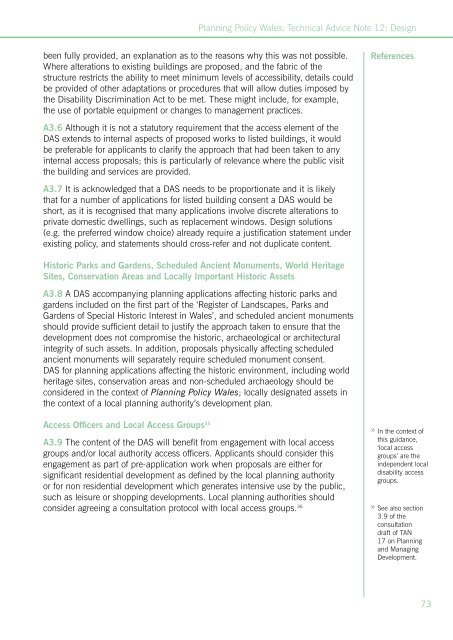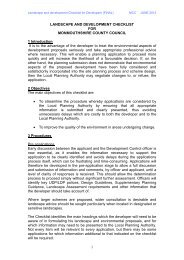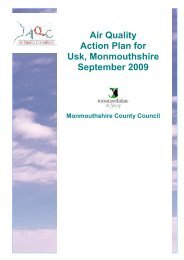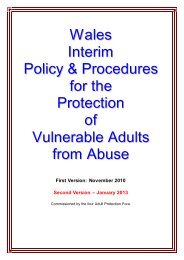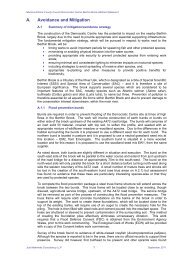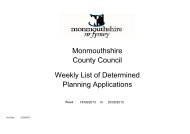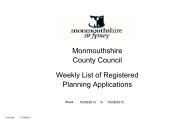Appendix 1 of the Technical Advice Note 12 'Design'
Appendix 1 of the Technical Advice Note 12 'Design'
Appendix 1 of the Technical Advice Note 12 'Design'
You also want an ePaper? Increase the reach of your titles
YUMPU automatically turns print PDFs into web optimized ePapers that Google loves.
Planning Policy Wales: <strong>Technical</strong> <strong>Advice</strong> <strong>Note</strong> <strong>12</strong>: Design<br />
been fully provided, an explanation as to <strong>the</strong> reasons why this was not possible.<br />
Where alterations to existing buildings are proposed, and <strong>the</strong> fabric <strong>of</strong> <strong>the</strong><br />
structure restricts <strong>the</strong> ability to meet minimum levels <strong>of</strong> accessibility, details could<br />
be provided <strong>of</strong> o<strong>the</strong>r adaptations or procedures that will allow duties imposed by<br />
<strong>the</strong> Disability Discrimination Act to be met. These might include, for example,<br />
<strong>the</strong> use <strong>of</strong> portable equipment or changes to management practices.<br />
References<br />
A3.6 Although it is not a statutory requirement that <strong>the</strong> access element <strong>of</strong> <strong>the</strong><br />
DAS extends to internal aspects <strong>of</strong> proposed works to listed buildings, it would<br />
be preferable for applicants to clarify <strong>the</strong> approach that had been taken to any<br />
internal access proposals; this is particularly <strong>of</strong> relevance where <strong>the</strong> public visit<br />
<strong>the</strong> building and services are provided.<br />
A3.7 It is acknowledged that a DAS needs to be proportionate and it is likely<br />
that for a number <strong>of</strong> applications for listed building consent a DAS would be<br />
short, as it is recognised that many applications involve discrete alterations to<br />
private domestic dwellings, such as replacement windows. Design solutions<br />
(e.g. <strong>the</strong> preferred window choice) already require a justification statement under<br />
existing policy, and statements should cross-refer and not duplicate content.<br />
Historic Parks and Gardens, Scheduled Ancient Monuments, World Heritage<br />
Sites, Conservation Areas and Locally Important Historic Assets<br />
A3.8 A DAS accompanying planning applications affecting historic parks and<br />
gardens included on <strong>the</strong> first part <strong>of</strong> <strong>the</strong> ‘Register <strong>of</strong> Landscapes, Parks and<br />
Gardens <strong>of</strong> Special Historic Interest in Wales’, and scheduled ancient monuments<br />
should provide sufficient detail to justify <strong>the</strong> approach taken to ensure that <strong>the</strong><br />
development does not compromise <strong>the</strong> historic, archaeological or architectural<br />
integrity <strong>of</strong> such assets. In addition, proposals physically affecting scheduled<br />
ancient monuments will separately require scheduled monument consent.<br />
DAS for planning applications affecting <strong>the</strong> historic environment, including world<br />
heritage sites, conservation areas and non-scheduled archaeology should be<br />
considered in <strong>the</strong> context <strong>of</strong> Planning Policy Wales; locally designated assets in<br />
<strong>the</strong> context <strong>of</strong> a local planning authority’s development plan.<br />
Access Officers and Local Access Groups 35<br />
A3.9 The content <strong>of</strong> <strong>the</strong> DAS will benefit from engagement with local access<br />
groups and/or local authority access <strong>of</strong>ficers. Applicants should consider this<br />
engagement as part <strong>of</strong> pre-application work when proposals are ei<strong>the</strong>r for<br />
significant residential development as defined by <strong>the</strong> local planning authority<br />
or for non residential development which generates intensive use by <strong>the</strong> public,<br />
such as leisure or shopping developments. Local planning authorities should<br />
consider agreeing a consultation protocol with local access groups. 36<br />
35<br />
In <strong>the</strong> context <strong>of</strong><br />
this guidance,<br />
‘local access<br />
groups’ are <strong>the</strong><br />
independent local<br />
disability access<br />
groups.<br />
36<br />
See also section<br />
3.9 <strong>of</strong> <strong>the</strong><br />
consultation<br />
draft <strong>of</strong> TAN<br />
17 on Planning<br />
and Managing<br />
Development.<br />
73


